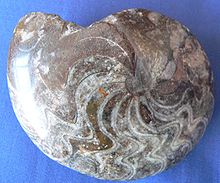Goniatites are a type of ammonite. They are cephalopods from the Order Goniatitida. They evolved from earlier forms in the Middle Devonian some 390 million years ago.[1]
| Goniatite Temporal range: Middle Devonian – Late Permian
| |
|---|---|

| |
| A polished Goniatite fossil | |
| Scientific classification | |
| Domain: | Eukaryota |
| Kingdom: | Animalia |
| Phylum: | Mollusca |
| Class: | Cephalopoda |
| Subclass: | †Ammonoidea |
| Order: | †Goniatitida Hyatt, 1884 |
| Suborders | |
All goniatites had an external shell like other ammonites. It was divided internally into chambers filled with gas, giving it buoyancy. An open chamber at the front of the shell was where the animal lived. It drew in and expelled water through a ventral spout called a siphuncle. They had a head with two well developed eyes, and arms (or tentacles). They were free-swimming.
Almost any fossil-bearing limestone or shale from inland seas of the late Paleozoic tropics or subtropics is likely to contain some goniatites.[2]
References
change- ↑ "Devonian Period | geochronology". Encyclopedia Britannica. Retrieved 2017-11-14.
- ↑ "ammonoid | fossil cephalopod". Encyclopedia Britannica. Retrieved 2017-11-14.
Wikispecies has information on: Goniatitida.